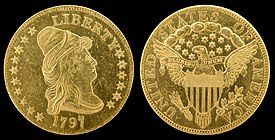This article needs additional citations for verification. (February 2013) |
The eagle is a United States $10 gold coin issued by the United States Mint from 1795 to 1933.
The eagle was the largest of the five main decimal base-units of denomination used for circulating coinage in the United States prior to 1933, the year when gold was withdrawn from circulation. These five main base-units of denomination were the mill, the cent, the dime, the dollar, and the eagle, where a cent is 10 mills, a dime is 10 cents, a dollar is 10 dimes, and an eagle is 10 dollars. The eagle base-unit of denomination served as the basis of the quarter eagle ($2.50), half eagle ($5), eagle ($10), and double eagle ($20) coins.
With the exceptions of the gold dollar coin, the gold three-dollar coin, the three-cent nickel, and the five-cent nickel, the unit of denomination of coinage prior to 1933 was conceptually linked to the precious or semi-precious metal that constituted a majority of the alloy used in that coin. In this regard the United States followed long-standing European practice of different base-unit denominations for different precious and semi-precious metals. In the United States, the cent was the base-unit of denomination in copper. The dime and dollar were the base-units of denomination in silver. The eagle was the base-unit of denomination in gold although, unlike "cent", "dime" (or "disme"), and "dollar", gold coins never specified their denomination in units of "eagles". Thus, a double eagle showed its value as "twenty dollars" rather than "two eagles".
The United States' circulating eagle denomination from the late 18th century through to the first third of the 20th century should not be confused with the American Eagle bullion coins which are manufactured from silver or gold (since 1986), platinum (since 1997), or palladium (since 2017).

